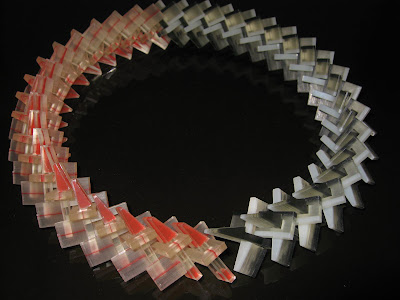I've
previously mentioned Oskar van Deventer's
Cooksey Tribute puzzles, a series of six puzzles inspired by a premise by Robert Cooksey. I encountered an apparent error in the puzzle while trying to solve the fourth in the series,
Cooksey Tribute D.
Oskar confirmed there had been a minor error, and graciously allowed me to 'print' my own replacement copy. Due to the width of the PVC material I discovered I could build two puzzles for exactly the same material cost as one. In fact, I could build three for the price of one if I built two of them upside down.

As usual, the models emerged surrounded by a solid cocoon of support material, which needs to be peeled away. The Cooksey Tribute D puzzle is supposed to be a hollow cylinder, so I concentrated on pulling the material out of the holes before I peeled away the external material. I figured it'd be easier to handle this way.

The hollow interiors are really deep and really narrow, so I couldn't pull out the support material with my fingers. Before long the only tool that could reach into the hole was a probe I'd bought at my local hardware store.

As it turns out, the probe was the perfect tool for hooking into the
X-shaped peeling cuts in the support material. This was an unusually challenging job because the holes were 11 cm deep, with 650 layers of support material. Luckily the probe made relatively quick progress, snagging several layers at a time.

When the holes were finally cleared, the block looked like this. It reminds me of a part from my '75 Scirocco's exhaust system. (I don't really miss that car.)

With the hollow interiors cleared, I began the easy job of peeling away the external supports to free the models.






































